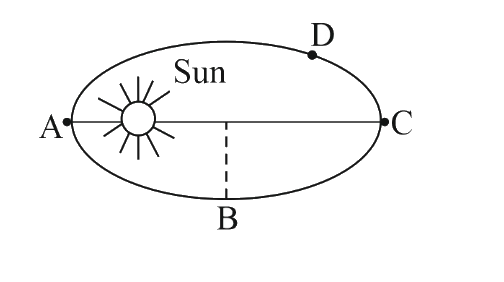All the planets move around the sun in
circular path
rectangular path
elongated elliptical path
none of the above
The correct Answer is:C
Step-by-Step Solution:
1. Understanding Planetary Motion:
- All planets in our solar system revolve around the Sun due to gravitational forces. The Sun's gravity pulls the planets towards it, causing them to move in specific paths.
2. Identifying the Path:
- The paths that planets take around the Sun are known as orbits. It's essential to determine the shape of these orbits to answer the question correctly.
3. Evaluating Options:
- The question provides four options for the shape of the orbits:
1. Circular path
2. Rectangular path
3. Elongated path
4. Elliptical path
4. Analyzing Each Option:
- Circular Path: While orbits can appear circular, they are not perfectly circular in reality.
- Rectangular Path: This is not a valid option as planets do not move in rectangular paths.
- Elongated Path: This term is vague and does not accurately describe the orbits of planets.
- Elliptical Path: According to Kepler's laws of planetary motion, planets move in elliptical orbits around the Sun.
5. Conclusion:
- Based on the analysis, the correct answer is that all the planets move around the Sun in an elongated, elliptical path.
Final Answer: All the planets move around the Sun in an elongated, elliptical path.
---
- All planets in our solar system revolve around the Sun due to gravitational forces. The Sun's gravity pulls the planets towards it, causing them to move in specific paths.
- The paths that planets take around the Sun are known as orbits. It's essential to determine the shape of these orbits to answer the question correctly.
- The question provides four options for the shape of the orbits:
1. Circular path
2. Rectangular path
3. Elongated path
4. Elliptical path
- Circular Path: While orbits can appear circular, they are not perfectly circular in reality.
- Rectangular Path: This is not a valid option as planets do not move in rectangular paths.
- Elongated Path: This term is vague and does not accurately describe the orbits of planets.
- Elliptical Path: According to Kepler's laws of planetary motion, planets move in elliptical orbits around the Sun.
- Based on the analysis, the correct answer is that all the planets move around the Sun in an elongated, elliptical path.
Topper's Solved these Questions
Similar Questions
Knowledge Check
- Question 1 - Select One
All planets revolve around the Sun in fixed elliptical paths called orbits. This motion is called ______ .
ARevolutionBRotationCGravitational motionDPeriod of rotation - Question 2 - Select One
A planet moves around the sun in an elliptical orbit with the sun at one of its foci. The physical quantity associated with the motion of the planet that remains constant with time is
AvelocityBcentripetal forceClinear momentumDangular momentum - Question 3 - Select One
A planet moves around the sun in an elliptical orbit. When earth is closest from the sun, it is at a distance r having a speed v. When it is at a distance 4r from the sun its speed will be:
A4vBv4C2vDv2
A planet revolves around the sun in an elliptical . The linear speed of the planet will be maximum at
 View Solution
View SolutionA planet moves around the sun. It is closest to sun to sun at a distance d1 and have velocity v1 At farthest distance d2 its speed will be
View SolutionFor a planet moving around the sun in an elliptical orbit, which of the following quantities remain constant ?
View SolutionA planet is revolving around the sun in an elliptical orbit. Which out of the following remains constant.
(a) Linear speed (b) angular momentum
( c) kinetic energy (d) potential energy (e) total energy throughout its orbit.View Solution...... suggested that Sun was at the center of our solar system and all the planets revolve around it and is also called the "father of Modern Astronomy
View Solution


